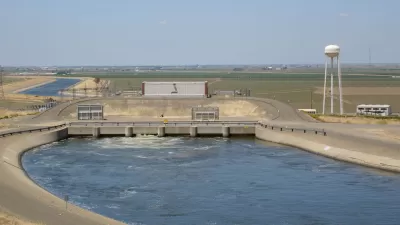As California faces its third dry year in a row, following the driest year in the state's recorded history, communities are facing the prospect of water rationing. However, some of the state's largest cities have been spared for the time being.
Though the images of barren mountain ranges normally covered in snow are startling, "from a hydrological and water supply perspective, the state is just now tipping into drought," observes Bettina Boxall. "Gov. Jerry Brown has not yet issued an official drought proclamation but said Monday that he soon will. 'It's really serious,' Brown said, noting that 2014 could be California's third dry year in a row. 'In many ways it's a mega-drought.'"
The seriousness of the situation, however, is spread unevenly across the state. Southern California and San Francisco should be able to ride out the drought without resorting to rationing for quite some time. "The story will be different for ranchers, communities that depend on local surface supplies and many San Joaquin Valley growers, particularly on the valley's south and west sides," notes Boxall. Sacramento approved mandatory rationing this week.
For an explanation of the unusual scientific phenomenon that's keeping the rain away (one researcher dubbed it the "Ridiculously Resilient Ridge"), see this article in the San Jose Mercury News. And for tips on how to reduce water demand and augment supply, Laura Tam has assembled a terrific list of tools for SPUR.
UPDATE (1/17/14): Governor Jerry Brown officially declared a drought emergency for the state this morning, report Josh Richman and Paul Rogers in the San Jose Mercury News. "The governor asked California residents and businesses to voluntarily reduce their water consumption by 20 percent. In practical terms, the drought declaration also streamlines the rules for water agencies to transfer extra water from one part of the state to another, easing shortages. It also raises public awareness."
FULL STORY: California areas brace for water rationing as reservoir levels fall

Planetizen Federal Action Tracker
A weekly monitor of how Trump’s orders and actions are impacting planners and planning in America.

Restaurant Patios Were a Pandemic Win — Why Were They so Hard to Keep?
Social distancing requirements and changes in travel patterns prompted cities to pilot new uses for street and sidewalk space. Then it got complicated.

Map: Where Senate Republicans Want to Sell Your Public Lands
For public land advocates, the Senate Republicans’ proposal to sell millions of acres of public land in the West is “the biggest fight of their careers.”

Maui's Vacation Rental Debate Turns Ugly
Verbal attacks, misinformation campaigns and fistfights plague a high-stakes debate to convert thousands of vacation rentals into long-term housing.

San Francisco Suspends Traffic Calming Amidst Record Deaths
Citing “a challenging fiscal landscape,” the city will cease the program on the heels of 42 traffic deaths, including 24 pedestrians.

California Homeless Arrests, Citations Spike After Ruling
An investigation reveals that anti-homeless actions increased up to 500% after Grants Pass v. Johnson — even in cities claiming no policy change.
Urban Design for Planners 1: Software Tools
This six-course series explores essential urban design concepts using open source software and equips planners with the tools they need to participate fully in the urban design process.
Planning for Universal Design
Learn the tools for implementing Universal Design in planning regulations.
Heyer Gruel & Associates PA
JM Goldson LLC
Custer County Colorado
City of Camden Redevelopment Agency
City of Astoria
Transportation Research & Education Center (TREC) at Portland State University
Camden Redevelopment Agency
City of Claremont
Municipality of Princeton (NJ)




























